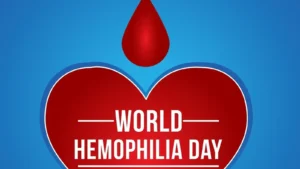Table of Contents
ToggleWorld Hemophilia Day: Raising Awareness for Bleeding Disorders”

World Hemophilia Day, observed on April 17th every year, aims to raise awareness about hemophilia and other inherited bleeding disorders. It highlights the challenges faced by those living with these conditions, including difficulties in accessing treatment and the need for better healthcare support worldwide. The day also promotes the importance of early diagnosis, proper care, and improved quality of life for patients. The World Federation of Hemophilia (WFH) uses this day to advocate for better research, treatment, and inclusion for people with hemophilia. Through education, collaboration, and global solidarity, World Hemophilia Day encourages the healthcare community and the public to support those affected by bleeding disorders.
What is Hemophilia?
Hemophilia is primarily an inherited disorder, and it most commonly affects males, though females can be carriers. There are two primary types of hemophilia: Hemophilia A, which is the more common type and caused by a deficiency of clotting factor VIII, and Hemophilia B, caused by a deficiency of clotting factor IX. People with hemophilia experience spontaneous internal bleeding or excessive external bleeding from even minor cuts or injuries, which can lead to severe complications, including joint damage, organ damage, and even life-threatening situations if not treated properly.
The condition varies in severity, with some individuals having mild hemophilia, where bleeding episodes are less frequent, and others experiencing severe hemophilia, where spontaneous bleeding can occur with minimal trauma.Hemophilia, though manageable with proper treatment, remains a lifelong condition, and individuals affected by it often require ongoing care, monitoring, and sometimes expensive treatments that involve infusions of clotting factors to prevent or control bleeding episodes.World Hemophilia Day is significant for several reasons.
It serves as a vital tool for the World Federation of Hemophilia (WFH) to engage with the global community, raise awareness, and promote advocacy for better care and treatment options for people with hemophilia and other bleeding disorders. The key objectives of the day include:

-
Education and Awareness:
Many people, especially in underserved regions, are unaware of hemophilia or do not understand the challenges individuals with bleeding disorders face. World Hemophilia Day focuses on providing information about the condition, its symptoms, and its management. By educating both the general public and healthcare providers, the day aims to improve diagnosis rates, reduce misdiagnoses, and promote early intervention, which can significantly improve patient outcomes. -
Advocacy for Better Care:
Despite advances in treatment, many people with hemophilia do not have access to the necessary healthcare, treatment options, or therapies. World Hemophilia Day calls for increased advocacy for equitable healthcare services and access to clotting factor therapies. Many countries, especially in low and middle-income regions, still lack the resources needed to provide adequate care to people with bleeding disorders. The day emphasizes the need for national governments and global healthcare organizations to invest in better health systems that cater to the needs of individuals with hemophilia. -
Encouraging Research and Innovation:
Research into hemophilia and its treatment has come a long way, but there is still much to be done. World Hemophilia Day encourages further research into finding more effective treatments, possibly even a cure for hemophilia, and improving the overall quality of life for individuals living with the disorder. The day brings attention to the need for ongoing funding and support for research initiatives that can lead to groundbreaking advances in gene therapy, clotting factor treatments, and long-term management strategies. -
Celebrating the Hemophilia Community:
The day also celebrates the resilience and strength of the global hemophilia community. It honors the individuals living with hemophilia, as well as their families, caregivers, and healthcare professionals who work tirelessly to improve their quality of life. It highlights the importance of community support, solidarity, and a collaborative approach to tackling the challenges faced by individuals with hemophilia.
The Role of the World Federation of Hemophilia (WFH)

The World Federation of Hemophilia (WFH), established in 1963, is the leading international non-governmental organization dedicated to improving the lives of people with hemophilia and other inherited bleeding disorders. The WFH has played a pivotal role in creating awareness, advocating for improved care, and providing training and resources to medical professionals globally. Through its programs, WFH works to strengthen healthcare systems, improve diagnosis and access to treatment, and provide support to individuals with bleeding disorders.
WFH’s programs also emphasize global cooperation, engaging local organizations, governments, and stakeholders in an effort to build more inclusive healthcare systems that offer equitable treatment to people with hemophilia. World Hemophilia Day is an integral part of this mission, as it helps generate momentum for these initiatives on a global scale.
Themes and Campaigns of World Hemophilia Day
Each year, World Hemophilia Day is associated with a theme that focuses on a particular aspect of hemophilia awareness, care, or treatment. For instance, in previous years, the theme has centered around topics such as “Access for All,” highlighting the importance of providing access to treatment, or “Advocacy and Empowerment,” emphasizing the need to support individuals with hemophilia through community-based efforts.These themes help raise awareness and direct attention to specific challenges and opportunities in the field of hemophilia care.
Additionally, campaigns around World Hemophilia Day encourage the global community to come together, share stories, and support advocacy initiatives. Social media campaigns, fundraising efforts, and public events are organized in various regions, helping to engage a broader audience and garner support for individuals with bleeding disorders.
Global Impact and Challenges

Despite the progress made in hemophilia care over the years, many individuals still face significant challenges due to the high costs of treatment, limited availability of specialized healthcare, and lack of awareness. It is estimated that more than 400,000 people around the world live with hemophilia, with many of them in developing countries where access to medical resources is scarce.In many low-income regions, access to clotting factor therapies remains limited, and individuals may not receive the necessary medical care to manage their condition effectively.
Additionally, cultural stigma, misconceptions about bleeding disorders, and inadequate healthcare infrastructure further complicate the situation for those living with hemophilia. World Hemophilia Day, therefore, plays a crucial role in pushing for global healthcare policies that ensure that all individuals with bleeding disorders, regardless of where they live, have access to life-saving treatments and quality care.
How You Can Get Involved
There are many ways to get involved and support World Hemophilia Day. Here are some ways you can contribute to raising awareness:
-
Spread Awareness: Share information on social media, distribute educational materials, and talk to friends, family, and colleagues about hemophilia and other bleeding disorders.
-
Support Organizations: Donate to organizations like the World Federation of Hemophilia and other local or global nonprofits that work toward improving the lives of individuals with hemophilia.
-
Participate in Events: Many events, including walks, fundraising campaigns, and awareness programs, are organized on World Hemophilia Day. Participating in these activities helps increase awareness and funds vital research and advocacy efforts.
-
Advocate for Change: Contact policymakers to advocate for improved healthcare policies and increased funding for bleeding disorder research and treatments.
1.There are two main types of hemophilia:
-
Hemophilia A: This is the most common form of hemophilia, caused by a deficiency in Factor VIII, one of the proteins responsible for blood clotting.
-
Hemophilia B: This type is caused by a deficiency in Factor IX. Although less common than Hemophilia A, it is still a significant concern for those affected.
Other related bleeding disorders include von Willebrand disease (which is the most common inherited bleeding disorder in the general population) and Factor VII deficiency, both of which also lead to clotting problems.
Hemophilia is X-linked, meaning the defective gene responsible for the disorder is located on the X chromosome. As a result, men are more likely to be affected by hemophilia because they have only one X chromosome. Women, on the other hand, can be carriers of the condition and may pass the defective gene to their children.
The condition ranges in severity from mild to moderate to severe. Individuals with severe hemophilia can experience spontaneous bleeding in muscles, joints, and internal organs, while those with mild hemophilia may only experience excessive bleeding following surgery or injury.
2. Prevalence and Global Impact
Hemophilia is a rare condition, but it affects a significant number of people worldwide. According to the World Federation of Hemophilia, it is estimated that there are about 400,000 people with hemophilia globally. While the disease is present in all regions of the world, access to care and treatments varies significantly, with those in low- and middle-income countries often facing challenges in receiving proper diagnosis and treatment.
In developed countries, people with hemophilia generally have better access to healthcare, including clotting factor replacement therapy, which helps reduce the risk of bleeding episodes. In low- and middle-income countries, however, access to this treatment is often limited, and many individuals may go undiagnosed or untreated, leading to complications that can be life-threatening.
3. The Importance of World Hemophilia Day
World Hemophilia Day was first observed in 1989 to honor the birthday of Frank Schnabel, the founder of the World Federation of Hemophilia (WFH). The WFH is a global non-governmental organization that has worked for decades to promote better care for individuals with bleeding disorders.
The observance of World Hemophilia Day serves several important purposes:
-
Awareness: It provides an opportunity to raise awareness about hemophilia and other bleeding disorders, including the challenges faced by those living with these conditions.
-
Education: World Hemophilia Day allows organizations to educate the public, healthcare professionals, and policymakers about hemophilia, its symptoms, and the importance of early diagnosis and treatment.
-
Advocacy: The day highlights the global disparities in healthcare access for people with hemophilia and other bleeding disorders. It calls for greater international efforts to ensure that everyone, regardless of where they live, has access to essential treatments.
-
Support: For people living with hemophilia and their families, World Hemophilia Day is an opportunity to show solidarity and raise their voices for better care and treatment options. It also encourages families and patients to connect with one another through support networks and advocacy groups.
4. Key Activities on World Hemophilia Day
World Hemophilia Day is marked by a variety of events, activities, and campaigns organized by the World Federation of Hemophilia and its global network of organizations. Some of the key activities include:
-
Social Media Campaigns: The WFH and other organizations use social media to spread awareness about hemophilia, sharing stories of individuals living with the condition, as well as information about treatment options. The hashtag #WorldHemophiliaDay is widely used to engage people and raise awareness.
-
Fundraising: Many organizations organize fundraising events, such as charity walks, runs, and auctions, to raise money for research and for providing treatment to those in need. Funds are also used to support advocacy efforts, ensuring that hemophilia is recognized by governments as a public health priority.
-
Educational Webinars and Conferences: Medical professionals and experts in hemophilia treatment often participate in online webinars and conferences to educate healthcare providers about the latest advancements in treatment and care. These events are also a chance for patients and their families to learn more about managing the condition.
-
Local Community Events: On the ground, local support groups and patient advocacy organizations hold events such as information sessions, patient support meetings, and blood drives to commemorate World Hemophilia Day. These events aim to unite individuals affected by hemophilia and provide them with valuable resources and emotional support.
-
Media Coverage: The WFH works with journalists and media outlets to ensure that World Hemophilia Day receives adequate coverage. Through articles, interviews, and special broadcasts, media outlets help spread the message of the day and educate the public on the realities of living with hemophilia.
5. Progress in Hemophilia Treatment
Thanks to medical advances, individuals with hemophilia today can live healthier and more active lives. The development of clotting factor replacement therapies has been a game-changer for many patients, allowing them to prevent or reduce bleeding episodes. In these therapies, patients receive clotting factor concentrates that are derived from either human plasma or produced through recombinant DNA technology.
Other advancements in hemophilia care include:
-
Gene Therapy: Recent research in gene therapy holds the promise of a potential cure for hemophilia. In gene therapy, the defective gene responsible for the clotting factor deficiency is replaced with a functional version, providing long-term benefits.
-
Prophylactic Treatment: Prophylactic treatment, which involves regular infusion of clotting factor to prevent bleeding episodes, is now common practice in many countries. This proactive approach significantly improves the quality of life for people with hemophilia.
-
Improved Diagnostic Tools: Early diagnosis and genetic testing have improved over the years, leading to more accurate and timely identification of hemophilia in children. This helps prevent long-term joint damage and other complications.
However, despite these advancements, access to these treatments remains a challenge in many parts of the world. The high cost of treatment, particularly in low-income countries, limits the ability of many to receive the care they need. The World Federation of Hemophilia and other organizations continue to advocate for better access to clotting factor therapy, especially in developing nations.
6. Challenges and Advocacy for Better Care
One of the primary challenges facing the hemophilia community is the lack of access to care, particularly in low-income regions. Many people with hemophilia, especially in rural areas, do not have access to proper diagnosis, treatment, or specialized healthcare professionals. In countries with limited healthcare infrastructure, patients often have to rely on outdated treatments or go without essential care altogether.
Awareness campaigns like World Hemophilia Day aim to bring attention to these issues and encourage governments and international organizations to address healthcare disparities. The goal is to ensure that every person with hemophilia can receive the care and treatment they need to live a full and healthy life, regardless of where they live.
7. Conclusion
World Hemophilia Day is a vital occasion to raise awareness about hemophilia and other bleeding disorders, advocating for better healthcare access, treatment options, and research. The day highlights the challenges faced by those living with hemophilia and fosters a sense of solidarity and support within the global community.
By continuing to raise awareness, educate the public, and advocate for better healthcare systems, World Hemophilia Day plays a crucial role in improving the lives of those affected by this rare and complex condition. Through global collaboration, we can work toward ensuring that everyone with hemophilia, no matter their background or location, has access to the care they need.
World Hemophilia Day serves as a reminder that while significant progress has been made in raising awareness and improving care for people with hemophilia, there is still much to be done. The day provides a platform to highlight the challenges faced by those with bleeding disorders, celebrate the resilience of the hemophilia community, and push for better healthcare systems, more equitable access to treatment, and groundbreaking research to improve the quality of life for individuals living with hemophilia around the world.
